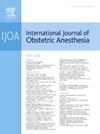比较竖脊肌平面和腹横肌平面阻滞在脊髓麻醉下剖腹产术后镇痛的效果:随机对照试验。
IF 2.6
3区 医学
Q2 ANESTHESIOLOGY
引用次数: 0
摘要
背景:截骨阻滞有助于多模式镇痛,从而促进剖腹产后的早期恢复。腹横肌平面(TAP)阻滞是一种成熟的腹壁躯体镇痛技术。竖脊肌平面(ESP)阻滞是一种筋膜平面技术,可提供额外的内脏镇痛效果。本研究假设,在脊髓麻醉下进行剖腹产的产妇中,ESP阻滞的镇痛效果将优于TAP阻滞:66名ASA身体状况1-3级(≥18岁)的患者在脊髓麻醉下接受择期剖腹产,他们被随机分配接受双侧超声引导下TAP阻滞(33人)或T9椎体水平ESP阻滞(35人)。主要结果是24小时累积吗啡消耗量。次要结果包括首次镇痛请求的时间、阻滞放置的持续时间、静息和运动时的数字评分表(NRS)疼痛评分、疼痛对日常生活活动(ADL)和婴儿护理的影响、患者镇痛满意度、阿片类药物相关副作用的频率和严重程度:两组 24 小时累积吗啡用量的平均值(95% CI)差异无统计学意义:TAP 为 32.0(27.0 至 37.0)毫克,ESP 为 27.0(19.9 至 34.0)毫克(P = 0.16)。ESP阻滞的平均(标清)持续时间比 TAP 阻滞长(10.7 (2.2) 分钟对 9.0 (2.5) 分钟;p = 0.004)。其他次要结果无明显差异:这项研究发现,在脊髓麻醉下进行剖腹产后,ESP阻滞和TAP阻滞的术后阿片类药物使用量和镇痛效果相似:南非国家临床试验注册中心(DOH-27-102022-5278):https://sanctr.samrc.ac.za/TrialDisplay.aspx?TrialID=8100,泛非临床试验注册中心(PACTR202301645957324):https://pactr.samrc.ac.za/TrialDisplay.aspx?TrialID=24267。本文章由计算机程序翻译,如有差异,请以英文原文为准。
Comparison of erector spinae plane and transversus abdominis plane block for postoperative analgesia after caesarean delivery under spinal anaesthesia: A randomised controlled trial
Background
Truncal blocks contribute to multimodal analgesia that enhances early recovery after caesarean delivery. The transversus abdominis plane (TAP) block is an established technique that offers somatic abdominal wall analgesia. The erector spinae plane (ESP) block is a fascial plane technique that may offer additional visceral analgesic effects. This study hypothesized that ESP block would offer superior analgesic efficacy to TAP block in women undergoing caesarean delivery under spinal anaesthesia.
Methods
Sixty-six ASA physical status grade 1–3 (≥18 years) patients undergoing elective caesarean delivery under spinal anaesthesia were randomly allocated to receive either bilateral ultrasound-guided TAP (N = 33) or ESP blocks at the T9 vertebral level (N = 35). The primary outcome measure was 24-hour cumulative morphine consumption. The secondary outcomes included time to first analgesic request, duration of block placement, numeric rating scale (NRS) pain scores at rest and movement, effect of pain on activities of daily living (ADLs) and care for the infant, patient analgesic satisfaction, frequency and severity of opioid-related side effects.
Results
There was no statistically significant difference in mean (95% CI) 24-hour cumulative morphine consumption between groups: 32.0 (27.0 to 37.0) mg with TAP versus 27.0 (19.9 to 34.0) mg with ESP (p = 0.16). The mean (SD) duration of block placement was longer for ESP than for TAP blocks (10.7 (2.2) minutes versus 9.0 (2.5) minutes; p = 0.004). There were no significant differences in the other secondary outcomes.
Conclusion
This study found similar postoperative opioid use and analgesic efficacy between ESP and TAP block after caesarean delivery performed under spinal anaesthesia.
Trial Registration: South African National Clinical Trial Registry (DOH-27-102022-5278): https://sanctr.samrc.ac.za/TrialDisplay.aspx?TrialID=8100, Pan African Clinical Trials Registry (PACTR202301645957324): https://pactr.samrc.ac.za/TrialDisplay.aspx?TrialID=24267.
求助全文
通过发布文献求助,成功后即可免费获取论文全文。
去求助
来源期刊
CiteScore
4.70
自引率
7.10%
发文量
285
审稿时长
58 days
期刊介绍:
The International Journal of Obstetric Anesthesia is the only journal publishing original articles devoted exclusively to obstetric anesthesia and bringing together all three of its principal components; anesthesia care for operative delivery and the perioperative period, pain relief in labour and care of the critically ill obstetric patient.
• Original research (both clinical and laboratory), short reports and case reports will be considered.
• The journal also publishes invited review articles and debates on topical and controversial subjects in the area of obstetric anesthesia.
• Articles on related topics such as perinatal physiology and pharmacology and all subjects of importance to obstetric anaesthetists/anesthesiologists are also welcome.
The journal is peer-reviewed by international experts. Scholarship is stressed to include the focus on discovery, application of knowledge across fields, and informing the medical community. Through the peer-review process, we hope to attest to the quality of scholarships and guide the Journal to extend and transform knowledge in this important and expanding area.

 求助内容:
求助内容: 应助结果提醒方式:
应助结果提醒方式:


